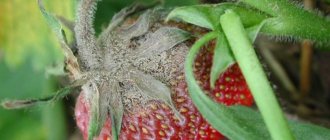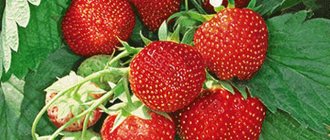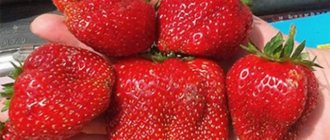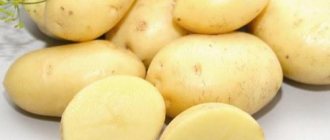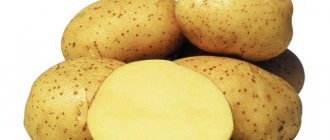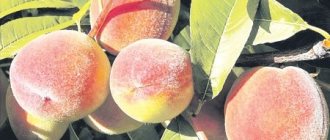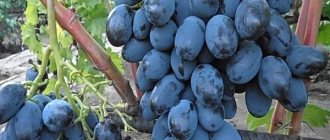Description
Bushes
The bushes are of medium height, vertical type of growth, weakly leafy, with medium-sized leaves of soft green color. The petioles of the leaf blades are slightly pubescent and of medium length. The flowers are pale white, collected in large inflorescences. The variety is characterized by the formation of bisexual flowers, so Vima Zanta does not need to plant pollinators. The flower stalks are massive, located at the level of the leaves, and tend to lie down under the weight of the berries. The bevel formation is enhanced.
A characteristic feature of Vima Zanta strawberry bushes is curled leaves.
Berries
Vima Zanta berries are large, symmetrical, round in shape, orange-red in color with light juicy pulp. The taste of the fruit is richly sweet, with a strongly pronounced aroma (in rainy years there may be sourness). The surface of the berries is matte.
The berries are easily separated from the stalk, including the sepals, which negatively affects their keeping quality and transportability. After picking, most of the fruits are deformed. In addition, the variety is characterized by an empty middle of the fruit, which is also a disadvantage and makes growing the variety unsuitable for commercial purposes. Due to their delicate consistency, the berries are also unsuitable for freezing; after thawing, they turn into a shapeless mass.
Productivity
Vim Zanta begins to bear fruit at the beginning of June. More precise dates depend on climatic conditions and agricultural technology. Average yields are about 500 g of berries per plant.
Pros and cons of the Vima Zanta variety
Strawberries have a number of benefits that we are happy to list:
- The main advantage of this variety is the size and taste of the berries. Moreover, if the weight of garden strawberries can reach 50 g, its sweetness and aroma stand out favorably against the background of other varieties of gigantic sizes;
- High yield - under the most favorable weather conditions and proper care, up to 2 kg of fruit can be removed from the bush;
- The culture loves the sun and does not fade on clear hot days, and this moment makes summer residents from southern latitudes very happy;
- Excellent resistance to such formidable diseases that can destroy the crop, such as verticillium, fusarium, gray rot, and other fungal and viral diseases of strawberry crops;
- The variety is classified as a hybrid, but has powerful vine formation, which allows you to easily propagate your favorite bushes. A great way to earn a little extra money!
Vima Zanta was not without its drawbacks:
- The complexity of commercial interests in mass planting for the sake of sale due to difficulties with transportation - the berries are very heavy and loose, requiring special equipment;
- The variety is demanding in terms of care, especially with regard to watering (cavities inside are usually caused by irregular moisture) and fertilizing;
- Loss of taste and beautiful shape of fruits when stored in the refrigerator;
- In cool and rainy weather, the crop often suffers from powdery mildew.
These data allow us to judge the variety as an excellent and productive find for personal farms or the possibility of sale in markets in the immediate vicinity of the place of cultivation.
a brief description of
Advantages of the variety
- excellent winter hardiness;
- high resistance to pests and diseases (especially Verticillium wilt);
- excellent taste of berries;
- good yield.
Disadvantages of the variety
- absolutely unsuitable for transportation and freezing;
- susceptibility to powdery mildew;
- a very large number of mustaches;
- sour taste of fruits in rainy seasons.
Vima Zanta inherited excellent resistance to most berry diseases from her eminent parents. From Corona it is resistant to root rot, from Elsanta it is resistant to gray rot and spotting.
Diseases and pests
The plant is resistant to major fungal infections:
- gray rot;
- verticillium;
- fusarium.
Cases of powdery mildew, although observed, are quite rare.
To combat pests (mites pose the greatest danger to strawberries), preventive treatments are recommended.
A separate problem is caused by slugs, which love to feast on ripe berries. For these pests, traps filled with beer or special compounds (Slugtop, Ulicide, etc.) have proven themselves to be best.
Growing and care
The main feature of the agricultural technology of the Vima Zanta variety is sparse planting. Even with slight thickening, yield indicators are significantly reduced, and the berries become smaller. The optimal planting pattern is 30-40 cm between plants and at least 60 cm between rows. It is very important to ensure timely removal of the mustache. On average, they are pruned 3-4 times during the growing season. If pruning is not carried out in a timely manner, then most of the bush’s energy will be spent on them. As a result, there will be significantly fewer berries.
When growing Vima Zanta, it is important to follow the correct feeding schedule. Fertilizers are especially important during flowering and ovary formation.
When growing Vima Zant strawberries, the following fertilizer application scheme is most often used:
- Early spring, immediately after the snow melts - urea at the rate of 20 g per m2. Stimulates the growth of leaf mass.
- End of April – complex mineral mixture. You can use any mineral complex intended for berry crops. The application rate depends on the specific manufacturer.
- After flowering - organic. For example, mullein, chicken droppings or fermented nettle infusion. Before use, they must be diluted with water in a ratio of 1:10. You need to be especially careful when using chicken manure. A solution that is too concentrated can cause burns, so chicken manure is often diluted in a ratio of 1:20.
- End of September – phosphorus-potassium complex. The use of nitrogen fertilizers during this period is unacceptable. The excess growth of leaf mass provoked by them will significantly reduce winter hardiness.
Strawberry care
Caring for any variety of strawberry involves performing the same actions. However, there are still some nuances. When caring for the Vima Zanta hybrid, you need to take into account the characteristics of both parent varieties. This is the only way to achieve a good harvest. The rules for caring for the Vima Zanta variety require the following actions:
- The hybrid loves abundant watering so that the berries are full-bodied. You will have to do this often. Moreover, during flowering it is impossible for water to get on the flower stalks. Watering plants at the roots is difficult, especially on large plantations. The only way out of the situation can be the arrangement of drip irrigation.
- The bushes of the Vima Zant hybrid are powerful, but they may not survive in thickets of grass. Weeds pull a lot of nutrients from the soil. It is better to do weeding in a timely manner, preventing the appearance of grass.
- If you want to get an early harvest, you will have to work hard. In the long spring, frosts are often observed. To prevent them from destroying young shoots, strawberries are covered with agrofibre at night. Such actions will help you get the first ripe berries about 10 days earlier.
- The Vima Zanta strawberry is considered a winter-hardy hybrid, but there is a threat of freezing. In the absence of snow, severe frosts or frequent thaws with freezing of the soil, the root system of plants suffers. You can ensure reliable insulation by covering strawberries with mulch for the winter. Straw, leaves, sawdust and other natural waste are suitable. Agrofibre can be used as mulch for winter shelter.
- Mulch is useful not only in winter, but also during the growing season. It will prevent rapid evaporation of moisture, protect plants from pests, and will also serve as an additional organic fertilizer. Sometimes gardeners even use pine tree needles for mulch.
- Recently, the technology of growing strawberries on film has gained wide popularity. The bed is covered with a black cloth, and windows are cut with a knife in the places where the seedlings are planted. The film prevents moisture from evaporating from the soil and prevents the growth of weeds.
The mustaches are removed from the strawberries so that they do not weaken the mother bush. However, the plant needs to reproduce. To obtain young shoots, 2-3 whiskers are left, and the strongest ones are chosen, and all weak little things are cut off with scissors.
Advice! To cause less injury to strawberries, it is better to propagate the plant after the berry picking has been completed.
Reproduction
The Vima Zanta variety is very easy to propagate with the help of numerous tendrils. Whiskers or, in other words, daughter rosettes are formed throughout the growing season. On average, one well-developed mother bush can produce up to 15-20 young plants. Most of the mustaches are formed by 2-3 year old bushes. As we age, conformation gradually decreases.
The advantages of reproduction with a mustache include:
- Full preservation of varietal characteristics.
- Almost 100% survival rate.
- Ease of reproduction.
To obtain the maximum number of runners, all peduncles are removed from the selected plants. This allows you to get the maximum number of daughter sockets. July whiskers are best suited for propagation. They manage to take root well before the onset of frost and therefore overwinter with virtually no losses.
For reproduction, it is best to use first-order whiskers. If necessary, the others can be used, but they are usually much smaller and weaker. For faster rooting, selected shoots are pinned to the ground and lightly hilled. As soon as the mustache takes root and begins to grow, they begin to be planted.
The rooted mustache is dug up using a scoop or small spatula. The dug plant is transferred to a pre-prepared planting bed.
When planting young bushes, it is necessary to monitor the depth level of the growing point. It should be slightly above ground level. Excessive deepening or elevation of the heart will lead to the death of the bush.
After planting is completed, the bed is watered abundantly, and the soil surface is mulched with a layer of straw, peat or humus. To create greenhouse conditions, seedlings are covered with a layer of non-woven material. It effectively protects from the sun while maintaining a constant level of humidity.
Description of the strawberry variety Vima Zanta
This Dutch variety is new for our summer residents. It was only registered in the Russian State Register in 2021. The well-known line of garden strawberries of the Vima series was marked by another bright star under the Zanta brand, along with the popular representatives Xima, Tarda, Kimberly and others. Our heroine is traditional, non-remontant, medium-early ripening, but sometimes you can find a description as ultra-early. It is famous for its gigantic size and excellent taste characteristics. If weather conditions are favorable, the first berries ripen by the end of May. Within about three weeks, in June, strawberries produce their main harvest, and it cannot be called particularly fruitful. Over the course of several weeks, berry picking will need to be done several times.
Vima Zant's strawberries have high immunity against fusarium, gray rot and verticillium wilt. There is susceptibility to powdery mildew in wet weather conditions and to attacks by various pests.
Origin and growing regions
The hybrid "Vima Zanta" appeared as a result of work on crossing the parent forms of "Elsanta" with "Corona" in Holland, by scientists from the company Vissers Aardbeiplanten BV. For more than ten years, variety trials of a hybrid variety have been carried out in our country. Only after this, registration took place in the register of selection achievements.
According to the regions of admission to cultivation, the following areas are recommended:
- the entire territory of Belarus,
- Northwestern and Central parts of Ukraine,
- Central region of Russia, since the variety is adapted to a temperate continental climate.
Vima Zant's strawberries will thrive in the fertile soil of open ground, as well as when cultivated under protective shelters and in greenhouses. The variety suffers from both excessive dry weather and prolonged rains with cold nights. Strawberries tolerate moderate cold well and are considered frost-resistant.
Bush
Strawberry bushes look powerful and quite spreading. Light green leaves with a thick cover protect the fruits from the sun.
Most often, the leaves are folded into a shape resembling a boat, and this is a special distinctive feature of the variety and should not be confused with manifestations of diseases. Almost every bush forms a mustache, which allows the summer resident to calmly take care of reproduction. Plump flower stalks grow slightly above the level of the leaves, but under the weight of large fruits they stick to the ground. White strawberry flowers are bisexual, so there are no problems with pollination.
Berries
The fruits of our strawberries are simply amazing. The average size of the berry is larger than a matchbox, weighing from 20-30 g on average, but the most giant ones reach 50-80 g.
Strawberries have a pleasant, matte, red color, sometimes with pronounced orange or burgundy hues. In the first harvest, the shape is spherical, then it approaches elongated, in the form of a cone, and may be flattened on the sides.
If the weather is pleasant and crop care is normal, then the harvest will delight you not only with its size, but also with a pleasant taste with a slight delicate sourness. Tasting scores for our heroine range from 4.5-5 - for a harmonious sweet taste. Some gardeners find the taste slightly cloying. There is also a slight hint of wild strawberries and a wonderful honey aroma.
Gardeners note that the taste characteristics and aroma of Vima Zanta are higher than those of representatives of the well-known varieties Honey and Clery. The pulp of the berry is lighter than the fruit surface, very juicy and loose, which brings pleasure when tasting, but creates problems with transportation. Some specimens may have cavities inside.
In addition, the dense and narrow sepals quickly come off and the berries themselves fall into the hands, which also creates an unsightly appearance for commercial purposes. Therefore, our heroine is positioned as an excellent option for personal plots. Strawberries are especially good when fresh, just picked, but they can also be used for various processing methods (jams, preserves, compotes).
Housewives advise not to freeze these strawberries, as the berries lose their shape and aroma.
Pollinators and productivity
Our variety is self-pollinating. It is believed that in order for the size of the berries to be close to the maximum according to the description, it is necessary to plant other varieties nearby with a similar ripening period. In this case, the fact that the pistils of all flowers in the plantings pollinate is important. Scientists claim that just over 50% of flowers self-pollinate; in windy weather, the result increases to 70%, and with the active participation of bees - up to 91%.
The productivity of Vima Zanta is high; up to 2 kg of fresh, tasty large berries can be harvested from the bush. From 70 to 100 centners of berry wealth are collected per hectare of plantings.
According to reviews of Russian gardeners, from 800 to 1500 g of berries are removed from a bush. The maximum yield of up to 2200 g/bush was recorded on farms in Belarus. In the first year, the harvest is smaller, about 600 g/bush, since the peak occurs in the second or third year, with a berry cycle of four years. The variety requires updating in the fifth year of cultivation, otherwise you risk acquiring diseases; the fruits themselves will be much smaller and less tasty.
In central Russia, provided the weather is sunny, gardeners harvest about 90 kg of berries from one hundred plantings.
Frost resistance
It is believed that strawberries are winter-hardy, but since they are recommended for temperate latitudes, it will be difficult for the bushes to withstand temperatures below -25°C. The crop requires feeding for the winter and mandatory shelter in latitudes with harsh winters. If return frosts are possible in the spring, you should also take care of protecting the beds.
Pest protection
In some unfavorable years, Vima Zanta strawberries may suffer from attacks by harmful insects. The most common ones are described in detail below.
Strawberry whitefly
A very small sucking pest that feeds on the sap of young leaves. Butterflies lay eggs on the underside of leaf blades. They hatch into larvae, which cause the main damage. The whitefly overwinters in plant debris and upper layers of soil. Up to 4 generations of the pest can be hatched per season.
Systemic insecticides are used to kill whiteflies. For example, Aktara shows a good result. The treatment is carried out twice. The first time is before the beginning of the flowering period, the second time is after picking the berries.
Strawberry leaf beetle
Small brown beetles that feed on leaves. The female strawberry leaf beetle lays eggs on the underside of the leaf blades. After 2 weeks, the eggs hatch into larvae that immediately begin to feed on the leaves. When heavily infected, the bushes grow severely deformed, and the ovaries on them die without having time to fully develop.
Adult beetles overwinter in plant debris. Therefore, the most effective measure to combat the strawberry leaf beetle is the timely destruction of tops and weeds. Insecticides used are Shar Pei or Karate.
Raspberry-strawberry weevil
A small dark gray beetle. Damages mainly young leaves, buds and ovaries. A characteristic sign indicating the presence of the raspberry-strawberry weevil is peduncles without buds. After eating part of the buds, the females lay eggs in them. The hatched larvae gnaw out all the contents. As a result, the crop is almost completely destroyed. To destroy the raspberry-strawberry weevil, plants are treated with Karate, Actellik and similar insecticides.
How to choose a variety for growing in your garden?
When choosing a variety of garden strawberries for planting, you must first decide on the type of fruiting. Ordinary plants bloom and produce crops once per season. Remontant ones bear fruit throughout the entire growing season.
Having fresh berries on the table all summer is a tempting prospect. But remontant varieties, in addition to their advantages, also have some disadvantages:
Saving space on the site (there is no need to keep several varieties with different ripening periods)
Greater need for fertilizers and watering
Early aging of the bush associated with depletion of the plant’s generative resources
The second important point when choosing is the purpose of the fruit. You need to decide what the strawberries will be grown for: for fresh consumption, for canning or for sale.
Fragrant varieties
Among the varieties with excellent dessert taste and aroma one can note:
Berries for canning and freezing
Strawberries that will be used for canning or freezing should have a denser consistency. The following varieties are suitable for this purpose:
The best remontant varieties
It is better to buy remontant or photoneutral varieties for sale, which can produce the maximum yield. In addition, the fruits of such strawberries should be well stored and transportable. For example:
- Mara de Bois;
- Queen Elizabeth II;
- Diamond;
- Albion;
- Evi 2;
- Victoria.
Other factors that need to be taken into account when selecting a variety of garden strawberries are ease of care and resistance to weather conditions. If it is not possible to spend a lot of time in the beds and care for the bushes, preference should be given to beardless varieties. In regions with harsh winters, it is important to choose frost-resistant strawberries. In humid climates, resistance to fungal infections becomes a serious argument.
Reviews
I grow 2 varieties of strawberries - Honey and Vima Zanta. The first one is larger-fruited and ripens about a week earlier. The second one is more tasty and aromatic. I have regular customers for Zanthu, who buy the berries only from me, for the unique caramel taste of the variety.
I brought the Vima Zanta variety to Novosibirsk from a relative living in Krasnodar. I tried her berries, they were sweet and aromatic, but I have a plastic taste, and there is no aroma either. Apparently, the variety does not grow on all soils and not in all climates.
Vima Zanta strawberries are considered the most delicious variety of the Vima line. It may be poorly suited for market sales, but for personal consumption it will be a worthy choice for any summer resident.
Garden strawberries and strawberries: feel the difference!
The species Garden strawberry is also called Pineapple strawberry, from the Latin name Fragaria ananassa. Of course, this plant has nothing to do with pineapples. We owe its appearance to the process of free pollination between Chilean and Virginia strawberries. Today there are about 10 thousand varieties of garden strawberries, which are often mistakenly called strawberries.
Garden strawberries (pineapple)
Strawberries and garden strawberries are different species of the same botanical genus. It is impossible to find real strawberries on store shelves, and they grow in garden beds only among collectors and breeders. In nature, this plant grows in the southern regions of Russia, Europe and Central Asia. Strawberries have a number of significant differences from garden strawberries:
- Strawberries are much smaller, more rounded, and their color is closer to purple-crimson rather than red.
- The fruits and flowers of strawberries are carried on the shoots above the leaves, while those of strawberries are located below.
- Strawberry fruits are difficult to separate from the bracts.
- Strawberry flowers are dioecious, so very few fruits are formed on the bushes.
Read also: About the Tristan strawberry variety: description, cultivation techniques, how to care
The taste and aroma of strawberries and wild strawberries are, as a rule, equally well expressed.
Landing requirements
The rapid adaptation of strawberry seedlings to a new place and its further growth depends on compliance with planting rules.
How to choose a place
For planting Vima Rina strawberries, the most suitable area is a well-lit, flat area or with a slight slope. The ideal direction is south or southwest. A little shading will not affect the formation of flower stalks. But strawberries planted in the shade will bear fruit poorly and the berries will lose their sweet taste. The delicate plant must be hidden from the north wind, for this you can use decorative plantings. But the air cannot be allowed to completely stagnate. Light ventilation will be an excellent prevention of fungal diseases.
To prevent the roots from suffering, you need to find a place where groundwater passes at a level of 60–80 cm from the surface of the soil cover. If the site is located in a lowland, then it is better to build high beds, since excessive dampness will not only spoil the harvest, but also lead to diseases.
Vima Rina grows well in almost all types of soil. But the highest yields will be produced on light and nutrient-rich soils. Compositions with high acidity are not suitable; they will have to be limed. Wetlands and saline lands are also unsuitable. On sandstones, the harvest will not please you due to the constant lack of moisture in the soil.
By planting Vima Rina after carrots, parsley, dill or radishes, you will achieve high yields. Garlic is a wonderful neighbor for strawberries - it helps repel pests from plantings. But the use of areas after potatoes, tomatoes, raspberries or eggplants is undesirable.
Garlic in a strawberry bed will help repel pests
Selection of seedlings
Planting material must be selected carefully, paying attention to the following parameters:
- the bushes must be well formed and have at least 3-4 leaves;
- the leaves are painted bright green and have no signs of disease or damage on the surface;
- The root system is fibrous, at least 7 cm long.
Strawberry seedlings must have healthy leaves and a developed root system
Time to disembark
Vima Rina strawberries can be planted in autumn or spring. But it’s still better to correlate the timing with the climatic conditions of your region.
Spring planting is preferable. The dates are limited to the end of April - beginning of May. You need to wait until the snow cover completely melts and the soil warms up to 100C. The young bush begins to bloom immediately after rooting. But the first flowers need to be plucked off without regret, then the strengthened plant will be able to please the next wave of harvest with large berries.
If you live in a region where return frosts are often observed in the spring, it is better to opt for autumn planting. It runs from late August to mid-September. It is important to have time to plant seedlings 2 weeks before the arrival of frost. In this short period of time, Vima Rina will have time to take root and lay flower buds, and with the arrival of spring it will grow rapidly.
You can plant Vima Rina strawberries in spring and autumn
Soil preparation
An important factor in obtaining high yields is good soil preparation before planting. The deeper the fertile layer, the stronger the root system grows and the more productive the bush becomes.
The preparatory period is always carried out in advance. For autumn planting, you need to put the ground in order a month before the start of the process. If the climate allows you to plant strawberries in the spring, then be sure to start preparing the site in the fall.
Before disembarking, you need to do the following:
- Dig the area to a depth of 30 cm, strawberries love clean soil, so carefully remove the roots of perennial plants;
- per 1 m2 add 6–8 kg of rotted manure or compost, 60–100 g of superphosphate, 30 g of potash fertilizers;
- Just before planting, loosen and level the soil.
Before planting strawberries, the soil must be dug up and thoroughly weeded.
Planting scheme
If the traditional scheme recommends maintaining 25 cm between strawberry bushes, then for the Vima Rina variety the distance between plants is increased to 40–45 cm. This will avoid thickening of the planting, and the berries will receive a sufficient amount of light. Leave at least 50 cm of free space between the rows.
Vima Rina's strawberries need space for normal development
Step by step process
- Sort through the planting material, remove yellowed leaves, shorten long roots to 6–7 cm.
- Dig holes measuring 25x25 cm.
- If fertilizers were not applied in advance, add them to the hole, thoroughly mixing with the soil.
- Spray each seat thoroughly with water.
- Plant the seedlings in the prepared holes. The roots should be directed straight down, the heart should be located above the surface of the earth.
- Lightly compact the soil around the bush, but not too much; the roots should have good air circulation.
- Water each bush again, making sure that the water does not get into the middle of the bush.
- Mulch the planting with straw or dry soil. This will help retain moisture in the soil longer, which means rooting will be more successful.
Vima Rina strawberries should be planted on a cloudy day or in the evening. If the seedlings were planted in the morning, they need to be protected from the midday sun. To do this, stretch non-woven material over the iron arches so that the top of the ridge is protected from the sun, and the bottom is slightly blown by the breeze.
Video: planting strawberries
Vima Rina
This variety is the leader of the vima series. Not because Vima Rina strawberries are fundamentally better than others. Causes:
- great popularity in Russia, Belarus, Ukraine;
- appeared in store catalogs earlier than other varieties in the series;
- in the vima group this is the only remontant strawberry.
Therefore, there are more reviews from gardeners about Vima Rina, which means it is possible to compare the description of the variety from manufacturers of planting material and retail chains with the actual results of Russian summer residents.
Bush
The plant is vigorous with dense, rich green foliage. These people need freedom in the garden, so they plant Vima Rina no closer than 40 cm in a row, and 60 cm between stripes. If there is not enough space, then in a checkerboard pattern.
The leaf is glossy, ribbed, slightly wrinkled. The petioles have sparse pubescence. The leaf blades are higher than the peduncles, so the berries have slight shading on the hottest days.
Flowers do not need pollinators, which is again appreciated by farmers who cultivate garden strawberries in greenhouses.
Berry
The peak period for fruiting is the second half of summer, if “vima rina” grows in ordinary beds. And under cover - almost all year round: from May to December.
Fruit characteristics:
- average weight - 30-40 g, the first in each wave - up to 100, the cycle ends with berries of 15-20 g;
- "Vima Rina" is medium-sized - regular cones, but the heavier the berry, the further from the ideal shape: there are both barrels and ridges;
- the taste in terms of points does not reach the maximum of literally a couple of tenths of a point, it is interesting with a cherry-cherry tint;
- small seeds do not reduce the pleasure of enjoying ripe “vimarina”, they do not crunch;
- inside the strawberry is dense, sugary, juicy, tender, voids are found only in huge specimens;
- universal purpose;
- keeping quality and transportability suit farmers, although they are not considered exceptional.
“Vima Rina” has already fallen in love with summer residents, but, according to reviews, it should be planted by those who visit the site regularly, and not just occasionally. Remontant strawberries need constant care.
Advantages of the variety
Strawberry “vima rina” as a variety is distinguished by the following advantages:
- remontant - bears fruit throughout the vegetative cycle, a new wave of flowering and ripening occurs after a month and a half;
- refers to a day-neutral garden dugout - does not depend on the duration of sunlight, and therefore is suitable for cultivation in closed ground;
- not tied to any specific region;
- low warp formation;
- high winter hardiness;
- tolerates heat and drought well, adapts to weather changes;
- good immunity to major infections;
- excellent yield - summer residents harvest at least 0.8 kg of berries per season, and with particularly careful care and favorable weather - up to 1.2 kg.
Only a very small number of mustaches is considered a disadvantage. But this indicator has already fallen into the merits of the variety. There is no contradiction: for those who want to quickly get more rosettes for reproduction, weak whisker formation is a clear disadvantage. But for summer residents who are satisfied with the number of Vima Rina bushes, this indicator is a plus: maintenance is easier, and there are enough rosettes for a gradual renewal of the plantation.
Basics of agricultural technology
Having mastered the classic care of remontant varieties, the gardener will cope with “vimarina”. Let us separately recall the main postulates:
- Planting in generously fertilized soil.
- Maintaining distance between bushes.
- Fertilizing throughout the season, depending on the phase - growth of greenery in the spring, flowering with fruiting, preparation for wintering.
- Watering strawberries.
- Disease prevention and pest protection.
Beginning summer residents: do not expect that, having planted Vima Rina once, you will reap the harvest for many years in a row. The culture is updated after 4 years, when productivity begins to decline. And since there are few mustaches, they are preparing to replace the plantation in advance and gradually.
Review video on Vima Rina garden strawberries:
Tips for growing strawberries
To grow healthy and tasty strawberries, you should pay attention to the following recommendations:
- The plant should be watered and fertilized only at the root, so as not to burn the leaves.
- You can get rid of slugs and ants that eat sweet berries by scattering dry mustard under the leaves.
- If strawberry rosettes are wrapped in straw, the berries will always remain dry, the slugs will go away, and there will be fewer weeds.
- Red pepper sifted through cheesecloth helps against cockchafer larvae, which love strawberries.
- You should not plant strawberries in the area after garlic.
- Dusting with ash protects strawberries from harmful insects.
- To attract bees, water strawberries with a weak honey solution (1 small spoon per 1 liter of water).
- They loosen the strawberries with a flat cutter, at the same time ridding the plantings of weeds. After weeding, weeds are left in the garden bed; they additionally mulch the soil.
How to care for berries
In order to provide the plant with suitable conditions for growth, it is necessary to take into account the features and characteristics that, for the most part, were inherited from its “parents”. It is also worth learning more about the Bereginya variety, for this you should read this article.
We are talking about resistance to diseases, high productivity and undemanding conditions for growing.
These indicators are very important in industrial cultivation, but for home cultivation, the priority will be the taste and quantity of fruit, so it is important to provide the strawberries with the most favorable conditions. How to properly plant the Black Prince variety, and how to properly care for it, is outlined in the article at this link
Video shows how to care for strawberries:
The main nuances of growing this variety:
The plant responds well to the drip irrigation method. This is most preferable, because without proper moisture, the fruit pulp may have voids, which reduces the marketable value and shelf life of the berries. Regular weeding and loosening the soil at the roots will give the plant access to nutrients
Despite the strong shoots, the bush may die in the thickets, so treat weeding with due attention. To obtain earlier harvests, it is advisable to provide spring shelter for the shoots. This will help the plant safely survive the threat of night frosts in late spring or changeable climates.
In this case, the first berry picking can be expected 7 to 10 days earlier, namely at the end of May. For winter shelter, it is also necessary to consider a system for protecting the root system. Despite its resistance to low temperatures, snowless winters or freezing during constant thaws can be detrimental to the plant. Mulching the soil is a proven way to preserve crops. This will also prevent moisture loss, reliably hide from pests and provide the necessary nutrition throughout the season. Straw, tree bark and pine needles can be used as mulch. You may also be interested in learning about how Sonata strawberries are mulched. Many gardeners practice the method of planting strawberries on agricultural film. It also helps control weeds and keep crops out of contact with the soil. For a more active harvest, it is recommended to cut off the stepsons so that the plant has enough strength. If young seedlings are needed, it is advisable to leave two or three shoots on the bush, and remove the smallest and weakest ones. This will give the strawberries a sufficient margin of safety to form young shoots without compromising yield. It is advisable to propagate the bushes after harvesting, so the plant is less damaged.
“Vima Zanta” is an elite variety of garden strawberries, which has adopted most of the advantages of its parents, no less outstanding specimens of Dutch selection.
High-yielding, unpretentious and resistant to most common diseases - this is not a complete list of the advantages of this species. You can read reviews about the Ostara strawberry variety here.
